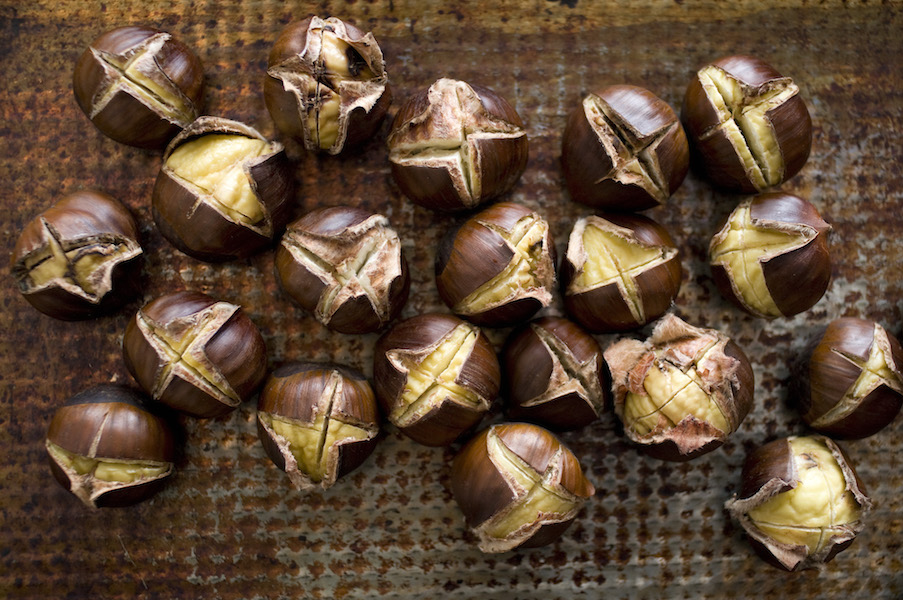Imagine a whole dinner of chestnuts, an answer to Marcel Proust’s madeleine releasing a flood of chestnut memories from the past. Are they so venerable? Are they digestible? Of course. Anything is possible when Brooklyn cooks.
This little brown orb is the food world’s Dr. Who. It appears in many guises at the table: savory, sweet or confectionary, solid or liquid, or even in its natural form. But please, don’t call it a nut: it’s 50 percent water and about 35 percent carbohydrates—a potato that grows on a tree. Caveat emptor: A chestnut is fresh when it feels heavy like a stone. Light as a potato chip? It’s been done in by improper storage. Compost it.
Sadly, Americans are to blame for the chestnut having lost its prominence in the European food chain. Since ancient times, the European chestnut (Castanea sativa) was a meaty staple in Western and Central Europe and the Mediterranean, used in stews, bread or roasted (some things never change). Those true tubers from the Andes—carried eastward by the conquistadors—eventually displaced the chestnut in the European diet as “the poor man’s meat.” Potatoes! They grow easily, they produce a crop quickly and they store like a dream.
On this continent, the bountiful American chestnut (Castanea dentate) provided food and shade for man, bird and beast—from the Atlantic to the Mississippi. And you took the chestnut road when you traveled—literally. The rails were iron, but what held the railroads together were chestnut ties. What finally killed off our chestnuts was an import. In 1904, a fungus in plant samples from Asia spread to the New York chestnut tree population. It was the botanical equivalent of the black plague. Within 50 years, all chestnut trees in the United States had succumbed to chestnut blight—an estimated 4 billion! The search for a blight-resistant chestnut tree has been one of horticulture’s holy grails since the 1970s, and the backcross breeding technique is bringing hope. There’s a Nobel Prize waiting for the botanist who finally cracks this nut.
If U.S.-grown chestnuts don’t fuel my annual dinner (despite the brief appearance at New York City’s Greenmarket of Chinese chestnut (Castanea mollissima) hybrids grown on local farms), whose chestnuts do? Enter Italy, which exports them to our shores each winter, as they’re still de rigueur in holiday dishes—which is exactly what my annual chestnut dinner wishes to challenge.
Chestnuts belong as much in the belly of the holiday beast as Jonah belonged in the belly of the whale. My Brooklyn Heights menu passes through countries and centuries, giving the chestnut’s cornucopia of flavors center stage.
And that’s exactly what’s happening in Europe each year at this time. In Spain, the Castanyada is celebrated in Catalonia on November 1, with panellet cookies; in Galicia it’s el Magosto, with roasted chestnuts and new cider keeping each other company. In Italy, on St. Martin’s Day (November 11), new wine flows and roasted chestnuts help absorb it. In France, many towns hold chestnut festivals, transforming them into crepes, jams, cakes, tarts, breads, honey and liqueurs. Greece, Austria and Hungary follow suit with their own chestnut delicacies.
Ready to throw your own chestnut feast? Copy Martial, the first-century AD Roman poet, and describe dessert in the dinner invitation:
If you want to try dessert, I can offer you raisins (my own),
Pears (from Syria),
And hot chestnuts (grown in Naples, city of learning),
Roasted in a slow-burning fire.
Next year in Naples!
How to Drink Chestnuts
Chestnuts in Cognac are a French holiday staple made by Clémont-Faugier in Privas, the axis mundi of the chestnut world (available in New York specialty shops). Chestnut liqueur, on the other hand, has been inexplicably absent from the U.S. wines and spirits scene for years. Pick up a bottle on your next trip to Paris. Astor Wines has come to the rescue, however, with a grappa that is a distillate of chestnut honey. At $99.99, save this for a very special occasion.
Story by Valerie Saint-Rossy
Photo credit: Erin Gleeson



